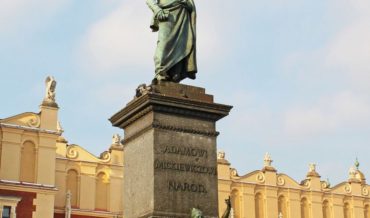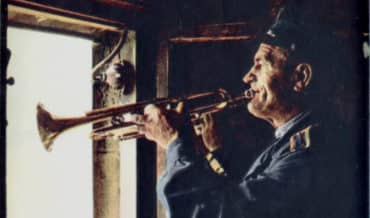Contents
Key Facts
- Born: 1888 in Mikulińce, Podolia (now Ukraine)
- Died: 1958 in Kraków
- Education: Academy of Fine Arts in Kraków (Jan Matejko Academy)
- Specialization: Religious sculpture, architectural decoration, and sacred art
- Major achievement: Advisory commission member for St. Mary's Basilica reconstruction
- Notable works: 12 apostles and 6 Polish saints in St. Mary's Basilica, Kraków
- Artistic style: Late Baroque-influenced neoclassicism with exceptional attention to physiognomic detail
- Legacy: Over 50 documented sculptures across Poland including Warsaw, Włocławek, and Jasna Góra
Early Life and Education
Karol Hukan was a distinguished Polish sculptor born in 1888 in Mikulińce, a town located in the historical region of Podolia (now part of Ukraine). This culturally diverse region, where Polish, Ukrainian, and Jewish artistic traditions intersected, profoundly influenced his later approach to religious iconography and his understanding of multicultural spiritual expression. The richness of this cultural intersection would later find echoes in Kraków's own diverse artistic heritage.
Hukan's formal artistic education began at the prestigious Academy of Fine Arts (Jan Matejko Academy) around 1906-1912. During this period, the academy was experiencing a renaissance under the influence of the "Young Poland" movement, which sought to modernize traditional Polish art while preserving its cultural essence. His professors likely included prominent sculptors of the era who emphasized both classical techniques and contemporary European trends.
The academy's curriculum provided Hukan with comprehensive training in:
- Classical sculpture techniques including marble carving and bronze casting
- Anatomical studies essential for realistic human representation
- Architectural integration of sculptural elements
- Religious iconography deeply rooted in Catholic tradition
- Contemporary European sculptural movements including elements of Art Nouveau and early modernism
Artistic Career and Specialization
Religious Art and Sacred Spaces
Hukan's artistic career flourished during the interwar period (1918-1939) when Poland regained independence and experienced a cultural renaissance. His work belongs to the tradition of Polish religious neoclassicism, characterized by emotional restraint combined with profound spiritual expression. Most of his documented sculptures are located in Kraków, making the city an essential destination for studying his artistic evolution.
His distinctive sculptural approach included:
- Shallow relief combined with deeply cut drapery creating dynamic interplay of light and shadow
- Individualized physiognomy where each figure displays unique facial characteristics and expressions
- Integration of Polish folk motifs within traditional Catholic iconography
- Use of local Carpathian sandstone alongside imported marble for contrasting textures
- Polychromy application on selected wooden sculptures to enhance devotional impact
Technical Mastery and Materials
Hukan worked primarily with Istrian marble, local Carpathian sandstone, and seasoned oak wood. His technical innovations included developing a particular method of surface texturing that made his stone sculptures appear almost lifelike under church lighting conditions. The sandstone he utilized was often sourced from the nearby Polish Jurassic Highland, which provided excellent quality materials for his sculptural work. Contemporary sources from the 1920s describe his workshop techniques as combining traditional Polish woodcarving methods with Italian marble-working traditions learned during a documented study trip to Rome in 1913.
Major Works and Commissions
St. Mary's Basilica – The Crown Jewel
Hukan's appointment as one of the members of the advisory commission for the reconstruction of St. Mary's Basilica in 1922 represented the pinnacle of his professional recognition. This commission, overseen by renowned architect Franciszek Mączyński, aimed to restore the church's medieval splendor while incorporating modern sculptural elements.
His masterwork in this sacred space consists of the carved heads of 12 apostles and 6 Polish saints, completed between 1924-1928. These sculptures demonstrate:
The 12 Apostles Series:
- St. Peter: Powerfully rendered with aged features reflecting a lifetime of devotion, showing traces of weathering that symbolize human frailty
- St. John: Depicted with youthful, idealized features contrasting sharply with Peter's earthly realism
- St. Andrew: Notable for his deeply carved beard and intense gaze directed upward in eternal contemplation
The 6 Polish Saints:
- St. Stanislaus: Portrayed in episcopal vestments with distinctly Polish facial features
- St. Adalbert: Showing missionary zeal through dynamic drapery and forward-leaning posture
- St. Hyacinth: Depicted holding a monstrance, emphasizing Eucharistic devotion
Each head measures approximately 45 cm in height and is carved from Istrian marble, chosen for its ability to capture fine facial details and its resistance to Kraków's variable climate.
Church of Saints Peter and Paul (Jesuit Church)
The Church of Saints Peter and Paul on Grodzka Street houses Hukan's six side altar sculptures and decorative elements created between 1920-1925. These baroque-style altars feature:
Specific Altar Dedications:
- St. Ignatius of Loyola Altar: Central figure showing the saint in moment of spiritual ecstasy
- St. Francis Xavier Altar: Depicting the missionary saint with cartographic elements referencing his Asian missions
- Sacred Heart of Jesus Altar: Featuring Christ with exposed heart, demonstrating Hukan's mastery of anatomical detail
The altar sculptures showcase Hukan's versatility in working with the existing 17th-century baroque architecture while adding his distinctive neoclassical interpretation.
Secular Commissions
The National Bank of Poland building at 31 Basztowa Street (current address) features Hukan's secular work in the form of allegorical figures representing Commerce, Industry, and Agriculture, completed in 1925. These three limestone sculptures adorning the building's attic demonstrate his ability to adapt religious sculptural techniques to symbolic representations of modern Polish economic life.
National Recognition and Broader Impact
Documented Works Across Poland
Hukan's authenticated works extend throughout Poland, with each location representing different phases of his artistic development:
Warsaw (1926-1930):
- St. Alexander's Church: Two angels flanking the main altar
- Warsaw Cathedral: Decorative elements in the Chapel of Literary Men
Włocławek Cathedral (1923-1925):
- Bishop's tomb sculptures: Three recumbent figures demonstrating his mastery of memorial art
- Sanctuary reliefs: Six panels depicting scenes from the life of Christ
Częstochowa – Jasna Góra (1928-1932):
- Votive chapel decorations: Sculptural elements celebrating Polish military victories
- Processional route stations: Outdoor sculptures designed to withstand pilgrim interaction
Sucha Beskidzka Parish Church (1935):
- Main altar centerpiece: Crucifixion group carved from local oak with selective polychromy
Artistic Context and Influences
Hukan's work represents a synthesis of Polish academic tradition with contemporary European religious art movements. His style shows influences from:
- Antoine Bourdelle's monumental religious sculptures
- Polish folk art traditions particularly in facial characterization
- Byzantine iconographic conventions adapted for Roman Catholic contexts
- German church sculpture of the early 20th century, especially in architectural integration
Contemporary art critics, including Jerzy Mycielski writing in "Sztuka" magazine in 1927, praised Hukan's ability to "breathe contemporary Polish spirituality into timeless religious forms."
Legacy and Influence
Karol Hukan died on March 15, 1958, in Kraków, having witnessed both world wars and the dramatic political changes that transformed Poland. His death marked the end of the interwar generation of Polish religious sculptors who had helped define the visual culture of independent Poland. This tradition of religious art continues to thrive in the region, with institutions like the Tyniec Benedictine Abbey maintaining centuries-old artistic practices.
Contemporary Recognition and Preservation
Today, Hukan's sculptures serve multiple cultural functions:
- Active devotional objects in liturgical settings across Poland
- Protected cultural monuments under the supervision of the National Heritage Board of Poland
- Study subjects for art history students at the Jagiellonian University and Academy of Fine Arts in Kraków
- Pilgrimage destinations particularly his works at Jasna Góra
The National Museum in Kraków houses several preliminary sketches and models for Hukan's major works, providing insight into his creative process.
Influence on Subsequent Artists
Several post-war Polish sculptors, including Alfons Karny and Stanisław Sikora, acknowledged Hukan's influence on their approach to religious art. His method of combining individual characterization with spiritual universality became a template for Polish ecclesiastical sculpture throughout the mid-20th century.
Art Historical Significance
Hukan's contribution to Polish sculpture extends beyond individual works to encompass his role in defining interwar Polish Catholic visual identity. His sculptures represent the successful integration of European artistic trends with distinctly Polish religious sensibilities, creating works that resonated both with local communities and international observers. This artistic synthesis was particularly significant in the context of Poland's rich Catholic heritage, which would later be embodied by figures like John Paul II, who understood the deep connection between faith and artistic expression.
His technical innovations, particularly in surface treatment of stone sculptures for optimal church lighting, were documented in the 1931 publication "Modern Church Art" by the Catholic University of Lublin and influenced church decoration practices throughout Central Europe.
Conclusion
Karol Hukan's artistic legacy represents one of the most significant contributions to 20th-century Polish religious sculpture. His works in St. Mary's Basilica, the Jesuit Church, and locations throughout Poland continue to serve both spiritual and cultural functions, attracting thousands of visitors annually to Kraków's historic Old Town churches. This area, along with historic sites like Wawel Castle, forms the cultural heart of the city where Hukan's artistic vision found its fullest expression.
For those interested in experiencing Hukan's masterful integration of traditional craftsmanship with modern artistic vision, Kraków offers an unparalleled opportunity to observe his evolution as an artist across different sacred spaces. The city's cultural diversity, which today manifests in events like the annual Jewish Culture Festival, echoes the multicultural influences that shaped Hukan's artistic perspective from his early years in Podolia.
His career exemplifies the successful synthesis of Polish cultural identity with universal religious expression, creating sculptures that speak equally to art historians, pilgrims, and anyone seeking to understand Poland's rich artistic heritage.
From the individualized apostles in St. Mary's Basilica to the baroque-integrated altars in the Jesuit Church, Hukan's sculptures remain vibrant testimony to the enduring power of religious art to bridge temporal and spiritual realms while preserving the cultural memory of a nation.

